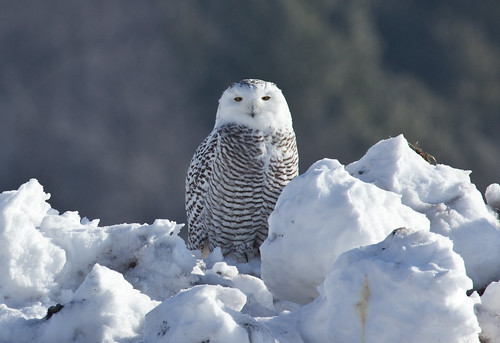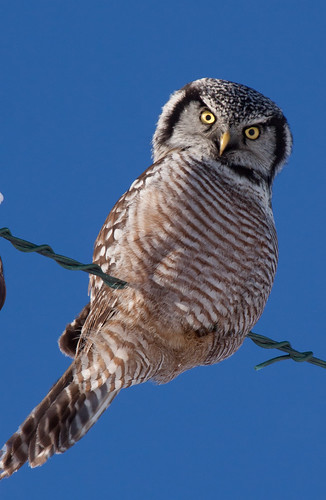
When Russ and I were living in Madison, Wisconsin in the late 70s, there was an invasion of northern owls into the Duluth area, and a lot of my friends drove up one weekend to see their lifer Boreal, Great Gray, and Northern Hawk Owls. I was sick with the flu and missed the trip, but from then on always associated northeastern Minnesota with incredible owls. After Russ earned his Ph.D. and had a few job offers, I lobbied for the one up here because of all those owls.
I’m not the only one who equates Duluth winters
with wondrous owls—year after year, people from every state and several foreign
countries come up, hiring guides or combing the Sax-Zim Bog on their own, all
in search of owls. In 1998, three men competed in a record-setting Big Year
memorialized in the movie The Big Year—all three of them came to Duluth to get
their owls. As digital photography and social media have grown in popularity,
the fame of our owls has mushroomed.
When people travel hundreds or even thousands of miles to
see and/or photograph an owl, and then spend a frigid winter day in a remote bog,
they want a payoff. But more and more, this wanting has evolved into a sense of
entitlement. Now many people arrive here armed with bait, so when they do spot
an owl, they can easily lure it in for close-ups and thrilling flight shots. Some professional birding guides (not the local ones that I know of) use bait so their participants will get incredible instead of
ordinary views, and a great many photographers do this.
They use two kinds of
bait—live rodents and dead or fake ones at the end of a fishing line. When they
spot an owl, they toss a hapless mouse or gerbil out onto the snow, or cast out
a fake one and reel it in. Our winter owls are astonishingly alert—they almost
always fly in instantly when they spy a rodent, instant gratification for the photographer that reinforces the practice.
Some
birders and photographers don’t see a problem at all. Some have enough
misgivings about the ethics that they are secretive about doing it. And some
twist arguments to act as if baiting is perfectly fine, or if not, is no worse
than setting out bird feeders for songbirds.
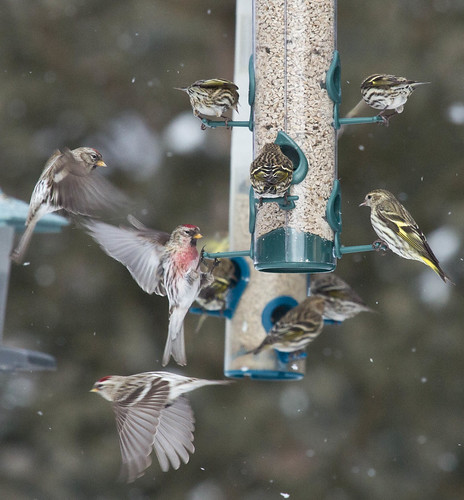

Baiting owls is not at all comparable to traditional bird
feeding. Americans have been offering breadcrumbs and seed to birds since before
the time of Thoreau and Emily Dickinson. Little by little, we’ve learned that
some practices are harmful—for example, we know that wet seed in spring can
provide a medium for botulism and other pathogens, that wet corn and peanuts
can become contaminated with aflatoxins, and that bread doesn’t provide enough
nutrition for most birds and can encourage House Sparrows, starlings, and
rodents. The Cornell Lab of Ornithology, which encourages backyard bird
feeding, has conducted decades of research into best practices, and
disseminates a huge body of accessible information far and wide to ensure that
backyard bird feeding is as healthy for the birds as it is enjoyable for
people.
No one has thoroughly researched any best practices with regard to owl
baiting. All we have are anecdotes. Most photographers and birders who lure
owls claim never to have seen any bad effects, but many impartial observers have witnessed
owls hurt or killed directly or indirectly due to baiting, and so the preponderance
of data is clearly against the practice. The Raptor Center in St. Paul, the OwlFoundation, the Raptor Education Group, and Project SNOWstorm, world-class organizations with a
thorough understanding of owls, are all on record opposing baiting, except by
licensed bird banders or to trap individual owls to remove them from a
dangerous situation or bring them to a rehab facility.
Baiting owls with fake mice is a horrible practice, immediately harmful to the owls. Owls cast pellets consisting of felted fur and all the bones and other indigestible matter in their prey. These pellets are formed in their lower stomach—the muscular gizzard—and must pass through the glandular stomach and esophagus to be spit out. These organs are emptied of fluids before the owl regurgitates the pellet. Before swallowing the next meal, the owl "primes the pump" by siphoning off body fluids back into these organs, which is accomplished as the owl spies and closes in on prey. Doing this and then coming up empty, as always happens when the owl chases a decoy, is very harmful, especially for owls that are hungry and growing dehydrated. When this is repeated over and over, as many photographers do for more photos, it's extremely frustrating for the poor owl as well as potentially destructive.
There are also many reasons why luring owls with live rodents is
bad for the owls. First, owls that are baited quickly learn to associate people
with food, sometimes leading to extremely dangerous situations for both people
and birds. And most baiting is done from roadsides, luring owls in to immediate
danger. Last year, one photographer actually tried luring a Boreal Owl across
busy Highway 61 so he’d have better light for photography, despite the fact
that Boreal Owls seldom fly above the height of logging trucks. Considering
that a primary cause of mortality for owls in winter is collisions with cars
and trucks, this was unconscionable.
In 1997, when a Boreal Owl turned up at the Springbrook Nature Center in Minnesota, the staff, concerned about the bird and thrilled about so many birders coming to see it, started providing daily handouts. The vast majority of the bird's pellets that winter consisted of white mice raised at the facility--it was feeding on very little natural food all season, but fortunately, the mice were raised at the nature center. When spring arrived, the owl didn't migrate north according to a post by Michael Hendrickson on MOU-net in 2009. I'd defended the feeding in 1997 because it was an exceptional situation--it was Mike Hendrickson's information and apparent inside knowledge about the fate of the bird that led me to think even that exceptional circumstance might not have warranted artificial feeding. Regardless, though, that was indeed an exceptional situation.
Northern owls seem far less fearful of people than most birds, often not fleeing until people have come within a few feet. There is no evidence that most of these species are the least bit tame, or associating people with food--they are simply trusting to their cryptic coloration and saving energy. Many spend their lives in remote areas where large mammals aren't particularly interested in them, so are less fearful than most birds. Northern Hawk Owls often actually approach people, whether or not the birds have been baited. They seem to share with Gray Jays the inclination to follow large predators in case they can capitalize on a feeding opportunity—there are records of them grabbing snipe shot by hunters before the hunters could retrieve them. I've taken many closeup photos of hawk owls, including the one at the top of this post, without ever baiting. I've also photographed them catching voles and other prey, no baiting involved.
When Boreal Owls descend on the North Shore of Lake Superior in winter, they are sometimes so hungry that they abandon their normal nocturnal habits and hunt by day. Photographing them is quite possible without baiting.
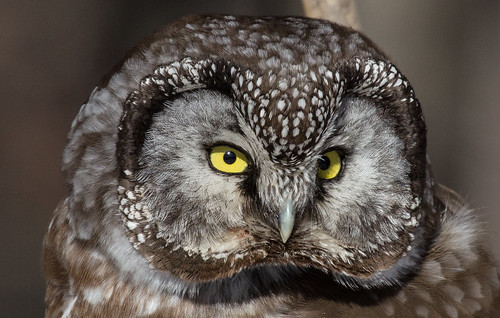
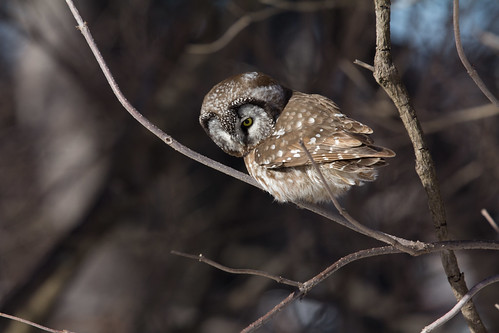
In 1997, when a Boreal Owl turned up at the Springbrook Nature Center in Minnesota, the staff, concerned about the bird and thrilled about so many birders coming to see it, started providing daily handouts. The vast majority of the bird's pellets that winter consisted of white mice raised at the facility--it was feeding on very little natural food all season, but fortunately, the mice were raised at the nature center. When spring arrived, the owl didn't migrate north according to a post by Michael Hendrickson on MOU-net in 2009. I'd defended the feeding in 1997 because it was an exceptional situation--it was Mike Hendrickson's information and apparent inside knowledge about the fate of the bird that led me to think even that exceptional circumstance might not have warranted artificial feeding. Regardless, though, that was indeed an exceptional situation.
Northern owls seem far less fearful of people than most birds, often not fleeing until people have come within a few feet. There is no evidence that most of these species are the least bit tame, or associating people with food--they are simply trusting to their cryptic coloration and saving energy. Many spend their lives in remote areas where large mammals aren't particularly interested in them, so are less fearful than most birds. Northern Hawk Owls often actually approach people, whether or not the birds have been baited. They seem to share with Gray Jays the inclination to follow large predators in case they can capitalize on a feeding opportunity—there are records of them grabbing snipe shot by hunters before the hunters could retrieve them. I've taken many closeup photos of hawk owls, including the one at the top of this post, without ever baiting. I've also photographed them catching voles and other prey, no baiting involved.
When Boreal Owls descend on the North Shore of Lake Superior in winter, they are sometimes so hungry that they abandon their normal nocturnal habits and hunt by day. Photographing them is quite possible without baiting.


Pet store rodents are notorious for carrying salmonella. The
Minnesota Department of Health and the Centers for Disease Control have
published accounts of children contracting salmonella, including
multidrug-resistant strains, from pet store mice, rats, and hamsters. The
affected children had merely played with and sometimes kissed their little
pets—as predators that consume the entire bodies of their prey, owls are even
more vulnerable to swallowing pathogens. Of course, as natural predators
feeding on raw meat, owls are more resistant to salmonella than we humans, but
two species that are baited extremely aggressively by photographers, Great Gray
and Boreal Owls, are typically most conspicuous when they are physiologically
stressed, with their immune system already compromised—this is when they would
be most vulnerable to disease organisms.
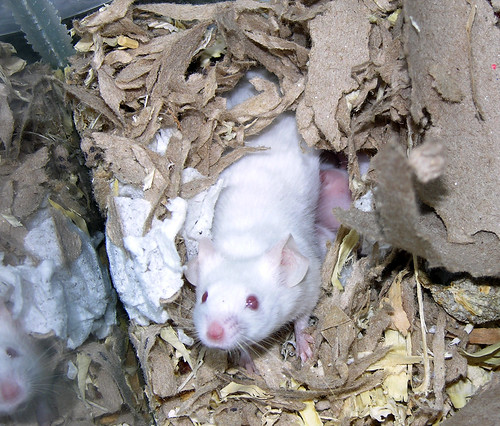

My focus has always been on birds, but I’m also partial to
rodents. It’s ironic that I’d consider the feelings of the little mice tossed
onto the snow, considering that I myself thaw out a mouse every night for my
education screech-owl Archimedes. But the frozen mice I purchase were raised
and then killed humanely and in clean circumstances so are guaranteed not to
harbor diseases, and I still feel sad about them. The ones tossed out on the
snow are kept warm and cozy right up to the moment someone grabs them out of a
cage and throws them onto the frozen landscape. Then, in the best-case
scenario, they get grabbed and devoured before they have time to think. In the worst-case
scenario, they escape, but are lost, bewildered, and cold. If they manage to
survive, that introduces another exotic species and its attendant parasites and
germs into the natural landscape.
Some photographers justify baiting owls by claiming that
their photos are valuable for conservation and environmental education, when in
reality many of these photos actually promote misinformation. One photo showing
a Great Gray Owl closing in on a mouse won awards and was conspicuously
displayed on the National Geographic and Nature Conservancy websites, even
though it was a house mouse on the surface of the snow—something that would
simply never happen in a wild situation. Over 90 percent of a Great Gray Owl’s
normal diet consists of meadow voles, which never walk on the surface of deep
snow—they construct tunnels at ground level under grass, so even when there is
no snow cover at all, voles stay out of sight. Unfortunately, by posting the
photo, these organizations were misinforming people about the way Great Gray
Owls normally hunt, and also providing misinformation about rodents. Suggesting
in a photo that a hamster or white mouse or brown house mouse is part of a wild
owl’s normal diet hardly promotes education. Unfortunately, magazine editors
don’t always recognize these unnatural situations themselves. Photographers claiming
to be photographing the natural world should not be using such unnatural set ups.
In some cases, baiting owls interferes with research that is
providing important information about owls. Scientists from the Northeast and
Great Lakes areas participating in the brand new Project SNOWstorm are
affixing GPS-GSM transmitters to Snowy Owls and then tracking them via the
Internet. Each transmitter costs $3,000. In this, the inauguration year of Project
SNOW Storm, we’ve already amassed a huge body of information about Snowy Owl
movements, activities, and what habitats they’re drawn to. But one bird bearing
one of these expensive transmitters in Ramsey County, Minnesota, is being
persistently baited by photographers, who have been giving it so much food that
it’s simply staying put. Scott Weidensaul of Project SnowStorm wrote a comment on the project blog:
We're aware of the situation in Ramsey, and very concerned about it. Jim [Williams] of the Minneapolis Star-Tribune has been writing about it, among others. The photographers feeding pet store mice to the owls are creating a situation in which the birds are becoming increasingly habituated to humans, which in a congested, suburban environment is especially risky. There's also the fact that Project SNOWstorm has invested thousands of dollars and a lot of collaborator effort in tagging Ramsey in order to learn how a wild snowy owl lives -- not to track a bird that's being fed by photographers too lazy to wait for natural behavior. It was our understanding that most of the feeding is targeted at the other, untagged snowy owl and not Ramsey, but that appears to be changing -- and it's not justified in either case. While it's not illegal, it is wrong, and we urge the photographers who are tossing mice to these owls to please stop.
The project website started out displaying real-time
movements of the birds, but because photographers were using the information to
rush in and bait them, Project SNOWstorm had to start putting a 3-day delay on the
tracking maps. Photographers, birders, and bird guides baiting these or any owls are compromising important
conservation or education work, not providing anything of value except to their
own egos and pocketbooks.
As a former licensed rehabber who handled lots of owls, as someone who has lived with my licensed education screech-owl for 14 years, and as someone who studied bird digestion (specifically nighthawks and owls) during my ill-fated Ph.D. project, this area is something I do have some small bit of expertise in. By next winter, the Minnesota DNR will have new regulations in place prohibiting owl baiting. And in my considered opinion, that’s the way it should be.
